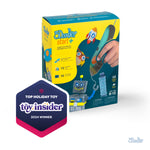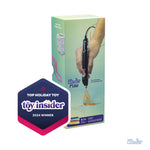Written By Brittany Ballou, K-5 STEAM Teacher, Grange Hall Elementary

STEAM is an acronym that stands for science, technology, engineering, art, and math, but what exactly does it mean? How can you integrate it seamlessly into your classroom? How will it enrich your students’ learning? In order to have the biggest impact on your students’ education, you want to truly understand all of the ins and outs of STEAM education.
When teaching STEAM you are not focusing on isolated subjects, but rather combining knowledge from all areas as students complete design challenges. When presented with a design challenge, students move through the engineering design cycle (ask, imagine, plan, create, improve, and share) to tackle the problem at hand. This approach allows teachers to be facilitators of learning as students take ownership of the content through project-based learning.
Through the engineering design cycle, students learn by researching the topic, trial and error during the building process, and discussion with teammates. Peer collaboration is a large part of STEAM education because students learn together as they brainstorm ideas and analyze their design through the testing phase.
The problems or challenges that you present to students should not have one right answer, but instead allow students to create a variety of solutions. The teacher is not prescribing a set path and correct solution, but rather allowing the creativity of the students to shine through. This method helps students learn how to approach problems in an organized and effective way – learnings which can set them apart in their future careers.

STEAM education enriches students’ lives because it provides an opportunity for them to apply their knowledge through real-world application. Students love to ask the question, “when am I ever going to use this in real life?” This is your opportunity to expose them to actual problems that involve the application of skills they are learning in the classroom.
While doing this, you can take the opportunity to inform them of the various career paths available to them. If students are never exposed to career paths, such as being an architect, software developer, or medical engineer that utilizes 3D-printing, then they will never have an opportunity to see what they could be when they grow up.
The goal of STEAM education is to create both analytical and creative thinkers. We want students to be able to think outside the box, collaborate with their peers, overcome obstacles, and apply their learning to benefit society. You too can do all of this in your own classroom! Below you will find lesson criteria to help you start implementing STEAM challenges with your own students, as well as tips to help you along the way.
Introduce the topic to students.
Find literature that goes with the topic. This is optional, but I love finding a new book to read to students. We discuss story elements and link science and/or math curriculum to the storyline with the STEAM challenge that is given.
Discuss background knowledge of the topic. This is where you unpack the standards you want students to review before giving them the STEAM challenge.
Present the STEAM design challenge to students so that they can relate it to things they already know, and feel connected to the problem.
Give students time to create a plan. Their plan should have a picture and be labeled with the materials they need to build.
You can provide a set amount of student materials to add the concept of limited resources to the lesson, or let them choose any materials they want.
Provide time for students to build, test, and improve their plan. This step can take as much time as, or more than, the previous work thus far.
Have students share their designs.
Tips:
STEAM education is not meant to be an “extra” thing to check off your to-do list. Instead, it should help you teach the assigned curriculum in an integrated way, accomplishing several class goals in one project. You should start by unpacking your curriculum standards. I find it helpful to start with science because it naturally lends itself to hands-on projects, but any area can be a starting point.
When you first start using STEAM challenges in your classroom, start small. Give students a time limit to complete the challenge (about 30 – 45 minutes). After students become comfortable with the engineering design cycle, you can complete more in-depth STEAM challenges that require multiple class periods to complete. For example, as you complete a unit of study in science, students can be simultaneously working on a STEAM project to apply and demonstrate their learning.
Not every STEAM project is going to work. Students are going to fail, and that’s ok! Your students will learn more by failing than they will by succeeding. Make sure they have some time to analyze what went wrong. They should always apply what they learn in one challenge and use it in future challenges.







